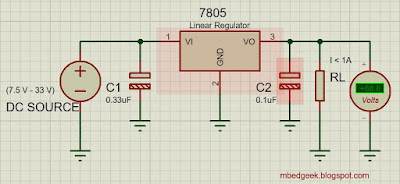Keywords : LM7805, LM2596, Linear Regulators, Buck Converters, Switch Mode Power Supply (SMPS)
Recap on 7805 Linear Voltage Regulator
We've had a previous discussion on Linear Voltage Regulators and Linear Drop Out Regulators. You can find the article here. Today we will discuss on the the difference between the 7805 Linear Regulator and the LM2596 Buck Converter.
 |
| IMG 01 : 7805 Schematic |
 |
| IMG 02 : Circuit on a breadboard |
 |
| IMG 03 : LM7805 output from an oscilloscope |
Now lets have a look at the LM2596 based buck converter module and then we'll go for the comparison.
 |
| IMG 04 : LM2596 Buck Converter Schematic |
 |
| IMG 05 : LM2596 Buck Converter Output from an Oscilloscope |
 |
| Commercially available LM2596 Converter Module |
Now we'll see the comparison between LM7805 and LM2596.
Comparison of Specifications
 |
| IMG 06: LM7805 and LM2596 Comparision |
 |
| IMG 06: LM7805 Efficiency Calculation |
Then,
Total Power Supplied = 20 V x 0.5 A = 10 Watts (Resistive Loads)
Resistive Load Power Consumption = 4.98 V x 0.5 A = 2.5 Watts
Efficiency
What happens to the rest of 7.5 Watts ? It is dissipated through the Linear Regulator. So higher the input Voltage and Current higher the power dissipation of regulator. Also, when power dissipation of the regulator increases, efficiency becomes lower. This is the biggest disadvantage of Linear Regulators. We'll be needing bigger heat-sinks when this power dissipation becomes higher. But in the case of Buck converters, they are very efficient and requires very minimum of additional heat sinks. Also when power consumption is critical (ex: battery powered applications) Buck converters would be really handy.Compactness and Cost
However linear regulators are much more compact and cost effective compared to Buck converters. Therefore they are widely used when efficiency is not a big concern. Also when the input voltage is very close to output voltage we can use linear dropout voltage regulators which may be efficient as much as buck converters due to lower voltage difference from input to output.Noise handling Capacity
See the Image 03 and Image 05 I've posted above. You will see that there is a small noise (voltage notch) present in buck converter output. It is said that there could be even higher noise in buck converter and may cause issues for some sensitive micro-controller applications. So in that case Linear Regulator seems to be slightly better.